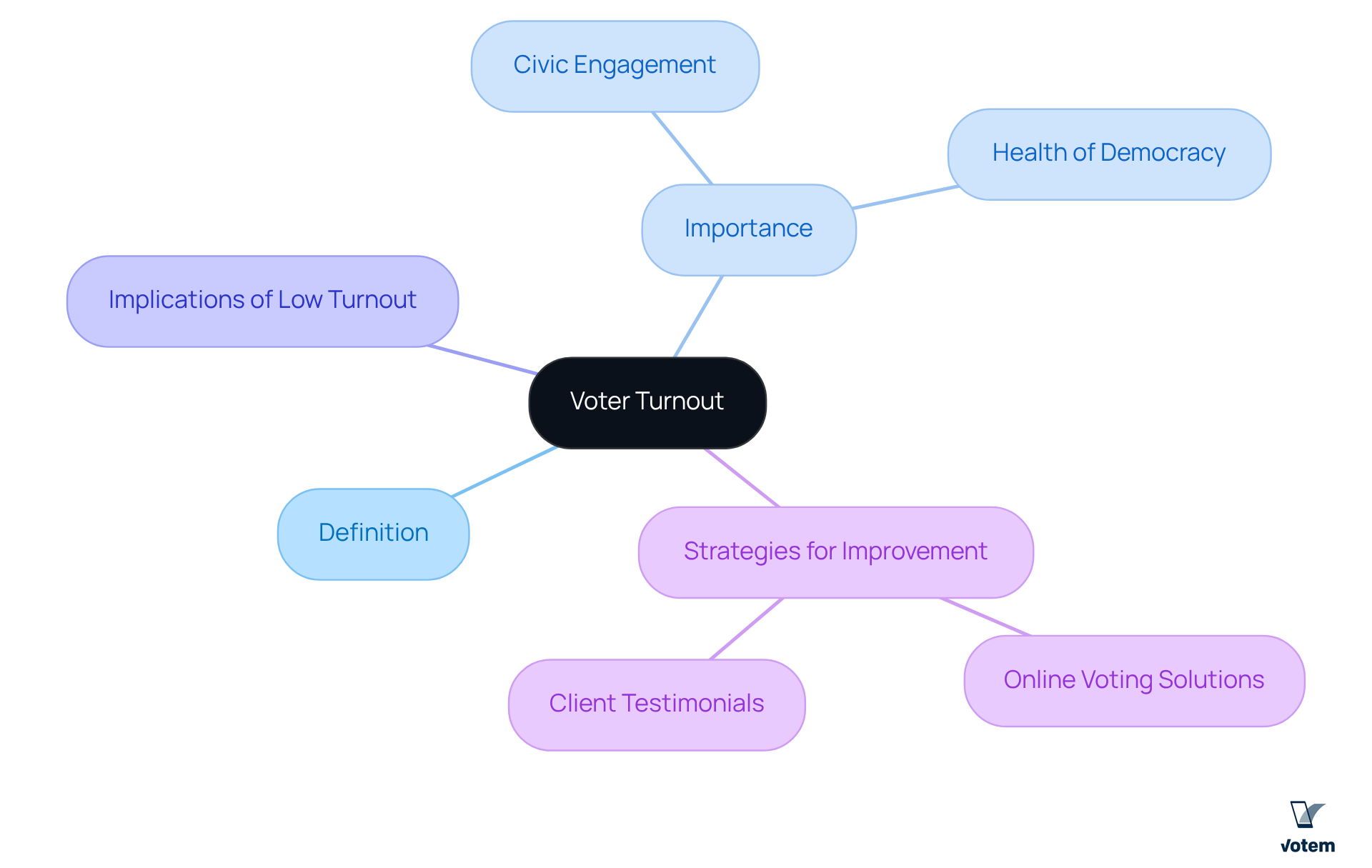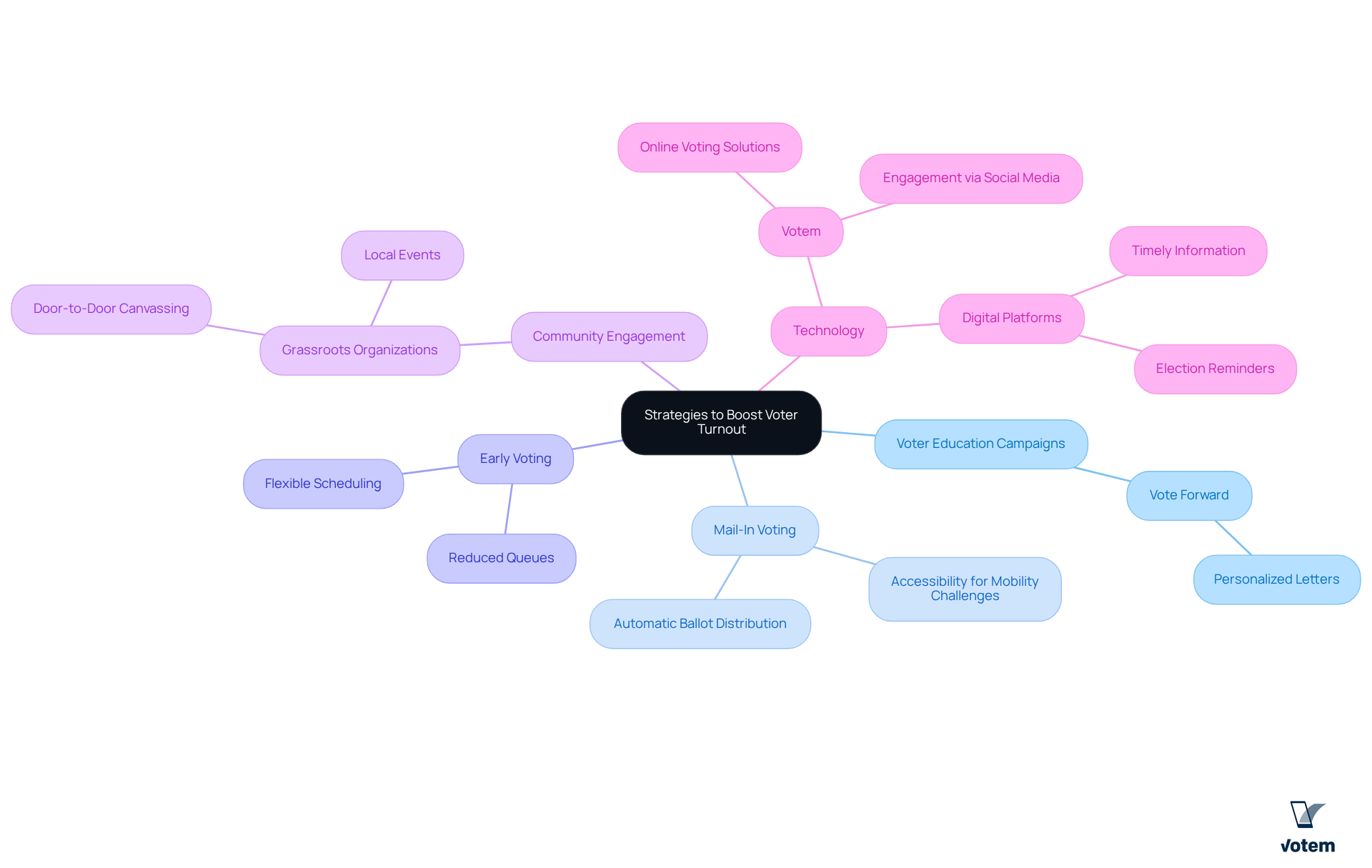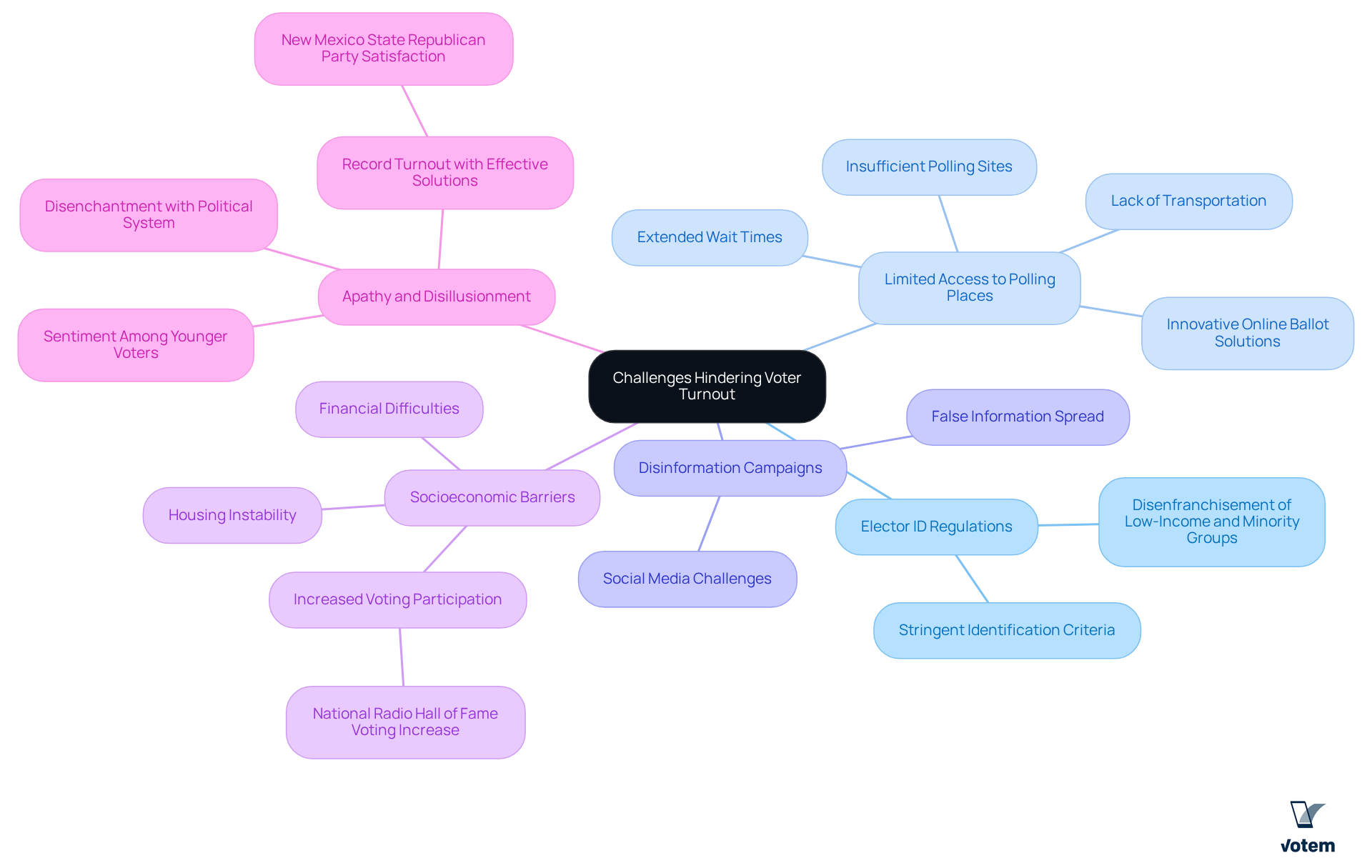Overview
To effectively increase voter turnout, several strategic steps have been implemented. These include:
- The execution of comprehensive voter education campaigns
- The expansion of mail-in and early voting options
- The adoption of advanced technology such as online registration and mobile ballot applications
Such initiatives not only enhance accessibility but also significantly boost engagement among voters.
The results speak for themselves. For instance, the handling of 299,000 votes for the National Radio Hall of Fame exemplifies the profound impact these strategies have on electoral involvement. By focusing on these methods, we can witness a substantial increase in participation rates, demonstrating the effectiveness of these initiatives in fostering a more engaged electorate.
Furthermore, it is essential to recognize the importance of these strategies in addressing the challenges faced by union leadership in mobilizing voters. The combination of education, accessibility, and technology serves as a powerful toolkit for driving electoral participation. As we move forward, it is crucial to continue refining these approaches to ensure that every voice is heard and represented in our democratic processes.
Introduction
Understanding voter turnout is essential for a thriving democracy, as it reflects the active engagement of citizens in the electoral process. Recent initiatives aimed at enhancing participation raise a critical question: what concrete steps have been taken to ensure that every eligible voice is heard? From innovative online voting solutions to targeted voter education campaigns, this article delves into the multifaceted strategies that are reshaping the landscape of electoral participation. Furthermore, it addresses the barriers that hinder this participation, providing insights into the ongoing efforts to create a more inclusive electoral process.
Define Voter Turnout and Its Importance
Participation in an election denotes the percentage of eligible individuals who cast their ballots, serving as a crucial indicator of civic engagement and the health of a democracy. High electoral participation is often associated with enhanced representation and accountability, reflecting the active involvement of citizens in the electoral process. Conversely, low participation can indicate apathy or disenfranchisement, undermining the legitimacy of elected officials and policies. Understanding what steps have been taken to increase voter turnout is essential for identifying obstacles to participation and developing strategies to improve civic engagement.
The organization has made significant strides in this area by implementing innovative online voting solutions that enhance accessibility and security, particularly in the context of Covid-19. Testimonials from satisfied clients underscore the system’s efficiency in boosting electoral participation. One client noted that the contemporary system facilitated increased access for all eligible individuals, including military personnel and those with disabilities, marking a notable achievement in their electoral initiatives. Furthermore, Votem successfully managed the receipt of 299,000 votes for the National Radio Hall of Fame, a substantial increase from the previous year, demonstrating their capability to handle large-scale voting efficiently. Such advancements not only enhance participation in elections but also promote a more inclusive electoral process, ensuring that every voice is heard.

Examine Strategies Implemented to Boost Voter Turnout
Numerous strategies have been implemented, raising the question of what steps have been taken to increase voter turnout in elections. Voter Education Campaigns stand out as a vital approach. By informing citizens about the voting process, deadlines, and the significance of their vote, participation can significantly increase. Organizations like Vote Forward exemplify this by sending personalized letters to motivate unregistered individuals. Furthermore, Mail-In Voting has proven effective, particularly for those facing mobility challenges or time constraints. States that automatically send ballots to registered individuals often observe higher participation rates. Votem’s innovative online voting solutions further improve accessibility for military personnel and individuals with disabilities, ensuring that all eligible participants can engage.
In addition, Early Voting allows individuals to cast their ballots before Election Day, effectively reducing long queues and scheduling conflicts. This facilitates the voting process, making it more accessible for everyone. Community Engagement through grassroots organizations mobilizes communities via door-to-door canvassing and local events, fostering a sense of civic duty and encouraging participation. Utilizing Technology is also paramount; digital platforms and social media campaigns effectively engage younger individuals, providing them with timely information and reminders about upcoming elections. The successful management of 299,000 ballots for the National Radio Hall of Fame illustrates the effectiveness of technology in enhancing participation.
These strategies, when customized for specific demographics and communities, can lead to substantial increases in electoral participation. Votem’s capacity to deliver over 123,000 votes—more than double the turnout from prior elections—demonstrates the potential impact of these initiatives. By implementing these strategies, union leadership can significantly enhance civic engagement by addressing what steps have been taken to increase voter turnout.

Analyze the Impact of Technology on Voter Engagement
Technology has fundamentally transformed the landscape of electoral engagement, raising the question of what steps have been taken to increase voter turnout?
-
Online Registration has emerged as a key advancement; many states now offer online voter registration, streamlining the process for individuals to enroll and update their information. This convenience is particularly impactful for younger voters, prompting the inquiry of what steps have been taken to increase voter turnout, potentially leading to increased registration rates.
-
Social Media Campaigns have also become essential tools for engaging the electorate. Platforms like Facebook and Twitter allow campaigns to reach vast audiences rapidly, sharing crucial information about candidates, issues, and election logistics.
-
Furthermore, Mobile Ballot Applications represent a notable innovation. Solutions such as Votem’s CastIron platform facilitate secure mobile voting, enabling voters to cast their ballots conveniently from their devices. This approach enhances accessibility for various groups, especially those who may face barriers to traditional voting methods. Studies indicate that mobile voting can significantly boost participation, prompting an inquiry into what steps have been taken to increase voter turnout, particularly among younger and tech-savvy demographics.
-
Lastly, Data Analytics plays a pivotal role in modern political campaigns. By employing data analysis, campaigns can identify and target potential constituents, tailoring messages to resonate with specific demographics. This targeted strategy not only enhances engagement but also raises the question of what steps have been taken to increase voter turnout by motivating individuals to participate in the electoral process.
While the benefits of technology are substantial, challenges persist, including cybersecurity concerns and the digital divide, which may exclude certain populations from meaningful electoral participation.

Identify Challenges Hindering Voter Turnout
Several challenges hinder voter turnout, including:
-
Elector ID Regulations: Stringent identification criteria can disenfranchise qualified individuals, particularly within low-income and minority groups who may lack the required documentation.
-
Limited Access to Polling Places: Insufficient polling sites, extended wait times, and lack of transportation can deter individuals from participating in elections, especially those with mobility challenges or demanding work schedules. The company’s innovative online ballot solutions enhance accessibility, allowing greater participation for all eligible individuals, including military personnel and those with disabilities. As noted by a satisfied client, “Implementing Votem’s new, modern system which allowed greater access for all qualified voters from military voters to voters with disabilities was my greatest accomplishment in office.”
-
Disinformation Campaigns: False information regarding the electoral process can create confusion and distrust, leading to lower participation rates. Social media platforms have struggled to combat the spread of misinformation regarding elections.
-
Socioeconomic Barriers: Individuals facing financial difficulties may prioritize work and family responsibilities over participating in elections, resulting in lower turnout. Additionally, housing instability can complicate registration and participation in elections. Votem’s solutions have effectively managed significant voting increases, as evidenced by the National Radio Hall of Fame’s receipt of 299,000 votes—an impressive rise from previous years.
-
Apathy and Disillusionment: Many potential participants feel disenchanted with the political system, believing their choice does not matter. This sentiment is particularly prevalent among younger voters. Votem’s efforts have shown that effective solutions can lead to record turnout, as demonstrated by the New Mexico State Republican Party’s satisfaction with Votem’s software, stating, “We will be using their services again in May for our State Party’s Quadrennial Election.”
Addressing these challenges requires a multifaceted approach, including policy reforms, community engagement, and targeted outreach efforts.

Conclusion
Voter turnout stands as a fundamental pillar of a healthy democracy, reflecting the active engagement of citizens in the electoral process. The steps taken to enhance voter participation are crucial in addressing barriers and ensuring that every eligible voice is heard. By focusing on innovative solutions, educational campaigns, and community engagement, we can achieve the objective of fostering a more inclusive electoral environment.
Key strategies—including voter education campaigns, mail-in voting, early voting, and the integration of technology—have proven effective in increasing participation rates. Initiatives such as online registration and mobile voting applications have further streamlined the process, making it more accessible, particularly for younger and marginalized populations. However, challenges persist, including stringent ID regulations, misinformation, and socioeconomic barriers that continue to hinder turnout.
Addressing these challenges necessitates a concerted effort from policymakers, organizations, and communities to implement reforms and outreach initiatives that resonate with potential voters. By continuing to innovate and adapt strategies for voter engagement, we can realize the goal of higher participation rates, ultimately strengthening the democratic process and ensuring that every citizen’s voice contributes to shaping our future.
Frequently Asked Questions
What is voter turnout and why is it important?
Voter turnout refers to the percentage of eligible individuals who cast their ballots in an election. It is important because it serves as a key indicator of civic engagement and the health of a democracy. High voter turnout is often linked to better representation and accountability, while low turnout may suggest apathy or disenfranchisement.
What does low voter turnout indicate?
Low voter turnout can indicate apathy or disenfranchisement among citizens, which can undermine the legitimacy of elected officials and the policies they implement.
How can understanding voter turnout help improve civic engagement?
Understanding voter turnout helps identify obstacles to participation, which can inform the development of strategies aimed at improving civic engagement and increasing electoral participation.
What steps have been taken to increase voter turnout?
Significant strides have been made by implementing innovative online voting solutions that enhance accessibility and security, especially in light of Covid-19.
How have online voting solutions impacted voter participation?
Online voting solutions have facilitated increased access for all eligible individuals, including military personnel and those with disabilities, thereby boosting electoral participation.
Can you provide an example of successful voter turnout initiatives?
Votem successfully managed the receipt of 299,000 votes for the National Radio Hall of Fame, which marked a substantial increase from the previous year, demonstrating their ability to handle large-scale voting efficiently.
What is the overall goal of advancements in voter turnout initiatives?
The goal of advancements in voter turnout initiatives is to enhance participation in elections and promote a more inclusive electoral process, ensuring that every voice is heard.

